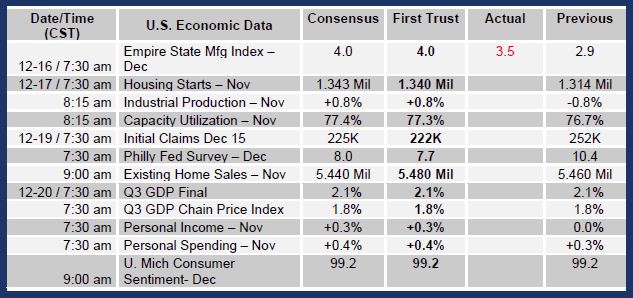Brian Wesbury Weekly Outlook
17.12.2019 11:16 - First Trust Global Portfolios Limited

S&P 3650, Dow 32500
A year ago, we projected the S&P 500 would hit 3100 at the end of 2019. In spite of the swoon in equities in the fourth quarter of last year, we didn’t see a recession coming and our model for estimating fair value for the stock market was screaming BUY.
At mid-year, seeing the economic and trade-policy stars aligning for further growth, and with our model for equites (more on that below!) still showing room for gains, we lifted our year-end forecast to 3250. At a Friday close of 3169, we were only 2.6% below that level with 16 days to go.
For 2020, we remain bullish. Our call is for the S&P 500 to end the year at 3650, which is about 15% higher than it finished on Friday, with the Dow Jones Industrials’ average moving up to 32500.
The first consideration we make when forecasting the stock market is whether we see a near-term recession. This step is important because even if the stock market is undervalued relative to long-term norms, a recession would almost certainly send equities lower in the short term; stocks would go from undervalued to more undervalued.
Needless to say, we don’t see a recession anytime soon. The economy is still adapting to lower tax rates and monetary policy remains loose. In addition, home builders are still generating too few homes given our population growth and scrappage rates, while banks are sitting on ample capital.
The second step, and usually the most important one, is to use our Capitalized Profits Model. The model takes the government’s measure of profits from the GDP reports, divided by interest rates, to measure fair value for stocks. Our traditional measure, using a current 10-year Treasury yield of 1.85% suggests the S&P 500 is grossly undervalued.
However, we think long-term interest rates are headed higher and this change can have a large effect on the model’s assessment of fair value. We anticipate that the 10-year Treasury yield will finish the year at 2.5%. Using 2.5% (instead of 1.85%) suggests an S&P fair value of 3775. In other words, we should finish 2020 with more room for the bull market to keep running.
In addition, it’s important to notice that in recent years operating profits generated by the companies in the S&P 500 have risen much more than the government’s measure of corporate profits that we use in our model. In the prior business cycle, the one that ended in the Great Recession, profits peaked in the second quarter of 2007. Since then, S&P operating profits are up 55% while the GDP measure of profits is up only 31%. This divergence suggests using the GDP measure of profits in our models may be underestimating the fair value of equities.
The biggest risk to our forecast is that someone on the far left wins the White House in 2020 and the Democrats simultaneously get a majority in the US Senate. We think that’s very unlikely. Most likely, the outcome of the election ensures that the tax cuts remain in place without any radical new entitlements or expansions of the entitlements already in place.
Like we said last year, this will probably to be one of the most optimistic forecasts you’ll see, if not the most optimistic one of all. But, in the end, we do best by our readers when we tell them exactly what we think is going to happen, without altering our projections so we can run with the safety of the herd.
Last year we told investors to “grit your teeth” because “those who stay invested in the year ahead should earn substantial rewards.” Our advice remains the same. The bull market is not yet done.
Brian S. Wesbury - Chief Economist
Robert Stein, CFA – Deputy Chief Economist
